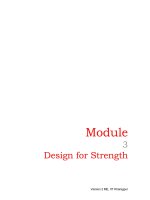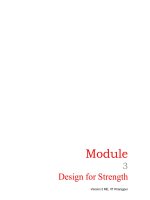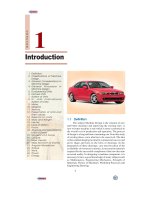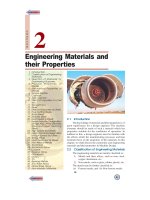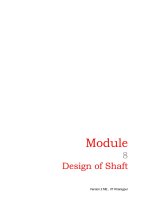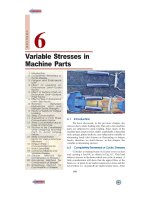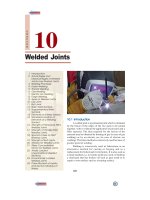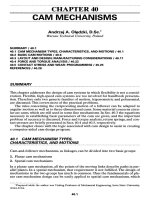Lecture Notes EEE 360 TOPIC 4 Synchronous Machine - Lecture 13 docx
Bạn đang xem bản rút gọn của tài liệu. Xem và tải ngay bản đầy đủ của tài liệu tại đây (1.49 MB, 77 trang )
06/29/14 360 Topic 6. Synchr.
Machine
•
1
Lecture Notes
EEE 360
George G. Karady
TOPIC 4
Synchronous Machine
Read Chapter: 7.1, 7.2, 7.4, 7.6, 5.6, 5.7
06/29/14 360 Topic 6. Synchr.
Machine
•
2
Lecture 13
06/29/14 360 Topic 6. Synchr.
Machine
•
3
Animation 1
Voltage induced in
a rotating loop
06/29/14 360 Topic 6. Synchr.
Machine
•
4
Energy Conversion
Concept:
•
Generators convert mechanical energy to electric energy.
•
Motors convert electric energy to mechanical energy.
•
The construction of motors and generators are similar.
•
Every generator can operate as a motor and vice versa.
•
The energy or power balance is :
–
Generator: Mechanical power = electric power +
losses
–
Motor: Electric Power = Mechanical Power +
losses.
06/29/14 360 Topic 6. Synchr.
Machine
•
5
Energy Conversion
Voltage generation
(Generator)
•
A wire loop is rotated in a
magnetic field.
–
N is the number of turns
in the loop
–
L is the length of the loop
–
D is the width of the loop
–
B is the magnetic flux
density
–
n is the number of turns
per seconds
D
B
L
06/29/14 360 Topic 6. Synchr.
Machine
•
6
Energy Conversion
Voltage generation
(Generator)
•
A wire loop is rotated in a
magnetic field.
•
The magnetic flux through
the loop changes by the
position
( ) ( )
tcosLDBt ω=Φ
n
π=ω
2
cos ωt
D
B
L
2
1
B
06/29/14 360 Topic 6. Synchr.
Machine
•
7
Energy Conversion
Voltage generation
(Generator)
•
Position 1 all flux links with
the loop
•
Position 2 the flux linkage
reduced
•
The change of flux linkage
induces a voltage in the loop
( )
( ) ( )
[ ]
( )
tsinLDBN
dt
tcosd
LDBN
dt
td
NtV ωω=
ω
==
Φ
cos ωt
2
1
B
06/29/14 360 Topic 6. Synchr.
Machine
•
8
Energy Conversion
Voltage generation
(Generator)
•
The induced voltage is an
ac voltage
•
The voltage is sinusoidal
•
The rms value of the
induced voltage loop is:
2
ω
=
LDBN
V
rms
cos ωt
2
1
B
•
View the animation of
voltage generation
06/29/14 360 Topic 6. Synchr.
Machine
•
9
SYNCHRONOUS MACHINES
Round Rotor Machine
•
The stator is a ring
shaped laminated iron-
core with slots.
•
Three phase windings
are placed in the slots.
•
Round solid iron rotor
with slots.
•
A single winding is
placed in the slots. Dc
current is supplied
through slip rings.
Concept (two poles)
N
S
A
-
B
+
A
+
C
+
C
-
B
-
A
B
C
Stator with
laminated iron-core
Slots with
winding
Rotor with dc
winding
06/29/14 360 Topic 6. Synchr.
Machine
•
10
SYNCHRONOUS MACHINES
Salient Rotor Machine
•
The stator has a laminated iron-
core with slots and three phase
windings placed in the slots.
•
The rotor has salient poles
excited by dc current.
•
DC current is supplied to the
rotor through slip-rings and
brushes.
•
The number of poles varies
between 2 - 128.
•
Concept (two poles)
N
S
A
+
B
+
C
+
B
-
A
-
C
-
06/29/14 360 Topic 6. Synchr.
Machine
•
11
SYNCHRONOUS MACHINES
Stator
Rotor
Connections
Bearing
Stator winding
Rotor winding
Housing ,cooling ducts
Shaft
06/29/14 360 Topic 6. Synchr.
Machine
•
12
SYNCHRONOUS MACHINES
Construction
•
The picture shows the laminated
iron core and the slots (empty
and with winding).
•
The winding consists of copper
bars insulated with mica and
epoxy resin.
•
The conductors are secured by
steel wedges.
•
In large machines, the stator is
liquid cooled.
•
The iron core is supported by a
steel housing.
•
Construction
empty slots
insulated
winding
06/29/14 360 Topic 6. Synchr.
Machine
•
13
SYNCHRONOUS
MACHINES
Stator
•
Laminated iron core
with slots
•
Steel Housing
06/29/14 360 Topic 6. Synchr.
Machine
•
14
SYNCHRONOUS
MACHINES
Stator details
•
Coils are placed in slots
• Coil end windings are
bent to form the
armature winding.
Slots
Coil
End winding
Iron core
06/29/14 360 Topic 6. Synchr.
Machine
•
15
SYNCHRONOUS MACHINES
Round rotor
•
The round rotor is used
for large high speed
(3600rpm) machines.
•
A forged iron core (not
laminated,DC) is
installed on the shaft.
•
Slots are milled in the
iron and insulated
copper bars are placed
in the slots.
•
The slots are closed by
wedges and re-enforced
with steel rings.
Round rotor
06/29/14 360 Topic 6. Synchr.
Machine
•
16
SYNCHRONOUS MACHINES
Rotor Details
06/29/14 360 Topic 6. Synchr.
Machine
•
17
SYNCHRONOUS MACHINES
Round rotor
Steel ring
DC current terminals
Wedges
Shaft
06/29/14 360 Topic 6. Synchr.
Machine
•
18
SYNCHRONOUS
MACHINES
Salient pole rotor construction
•
The poles are bolted to the shaft.
•
Each pole has a DC winding.
•
The DC winding is connected to the slip-rings (not shown).
•
A DC source supplies the winding with DC through brushes
pressed into the slip ring.
•
A fan is installed on the shaft to assure air circulation and
effective cooling.
06/29/14 360 Topic 6. Synchr.
Machine
•
19
SYNCHRONOUS MACHINES
06/29/14 360 Topic 6. Synchr.
Machine
•
20
SYNCHRONOUS
MACHINES
Construction
•
Low speed, large hydro-
generators may have more
than one hundred poles.
•
These generators are
frequently mounted vertically.
•
The picture shows a large,
horizontally arranged
machine.
06/29/14 360 Topic 6. Synchr.
Machine
•
21
Animation 2
Generator
Operation
06/29/14 360 Topic 6. Synchr.
Machine
•
22
Test 2
Transformer
06/29/14 360 Topic 6. Synchr.
Machine
•
23
Lecture 14
06/29/14 360 Topic 6. Synchr.
Machine
•
24
SYNCHRONOUS MACHINES
Operation concept
•
The rotor is supplied by DC current I
f
that generates a DC flux Φ
f
.
•
The rotor is driven by a turbine with
a constant speed of n
s
.
•
The rotating field flux induces a
voltage in the stator winding.
•
The frequency of the induced
voltage depends upon the speed.
Operation (two poles)
N
S
A
+
B
+
C
+
B
-
A
-
C
-
Flux Φ
f
n
s
06/29/14 360 Topic 6. Synchr.
Machine
•
25
SYNCHRONOUS
MACHINES
Operation concept
•
The frequency - speed relation is f = (p / 2) n
s
= p n
s
/ 2
p is the number of poles.
•
Typical rotor speeds are 3600 rpm for 2-pole, 1800 rpm for 4 pole and
450 rpm for 16 poles.
•
The rms. value of the induced voltages are:
•
where:
k
w
= 0.85-0.95 is the winding factor.
degOi
rmsan
eEE =
degi
rmsbn
eEE
120−
=
degi
rmscn
eEE
240−
=
wfa
faw
rms
kNf.
Nk
E Φ
Φ
444
2
=
ω
=

